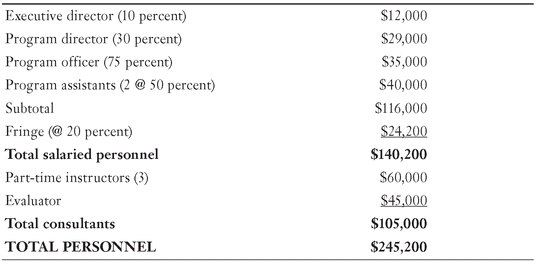Who
Funders want to know who will be involved in carrying out a project, so this is an important part of every budget. Staff, consultants, and volunteers all have a place in this part of your budget. In thinking about staff, don’t forget support staff and supervisory staff. They may spend only a fraction of their time on a project, but some portion of their salaries should be included.
And think about what you’d have to pay people to do the work of your volunteers. If you include volunteers in your staffing, list them on a separate line and put a corresponding line for the same amount in the Income section of the budget as donated services.

PHILANTHROPY FACT
Salaries at nonprofits became headline news several years ago when the exorbitant salaries of a very few executives were made public. Since then, the public perception has seemed to be guilty until proven innocent. There’s a much greater expectation today that charities will make this information readily available, however uncomfortable it might make nonprofit executives.
I’ll Take 75 Percent of a Program Officer and …
Seldom will you actually use an employee’s full salary in a program budget. It’s a fact of nonprofit life that most of us have a variety of duties that cross a number of program areas. More typically, you’ll have a listing such as the following:

The percentages reflect the amount of each employee’s time spent on the program. Always include them to help the funder understand how the program will be staffed. You’ll need to consult with the person in charge of the program to get an idea of what percentages to use. If he has trouble coming up with a percentage, ask him how many days a week he’ll spend on the program. You can use that to determine the percentage (1 day a week = 20 percent).
If you’re including volunteers in your budget, value their time for what you would have had to pay someone to do the job.
Fringe Benefits
The bane of nonprofit budgets these days is fringe benefits. Insurance rates of all types seem to go up and up, so it’s only fair that a funder who’s paying part of someone’s salary cover a proportionate amount of her fringe benefits. Your charity probably has an average number to use for fringe benefits (possibly 20 percent or even more). Get this from your finance staff, and use it consistently in all applications. (You don’t need to worry about who signed up for the dental plan and who didn’t; an average rate will do.)
The Full Personnel Budget
Your proposal will need a detailed personnel budget, showing how the program will be staffed, including all consultants.
Personnel Budget

This presentation clearly shows how much time the charity’s staff will spend on the program and what parts of the program they’ll entrust to outside contractors (consultants).
Typically, only small portions of higher-level staff members’ salaries will be attributed to a single program. Obviously, these are the people with the widest responsibilities. For example, attributing 30 percent of the executive director’s time to a program would raise eyebrows at the funder unless yours is a very small agency with few programs and where the executive director actively participates in programs on a daily basis. Including small parts of high-level employees, however, is good budgeting that contributes to your charity’s bottom line.

WORDS TO THE WISE
Personnel expenses are one of the fuzzier items (or fungible numbers) in a budget. That your executive director has something to do with most programs is obvious; the exact amount of time she spends on each program is less clear. The ability to find ways to include operating expenses (such as administrative salaries) in a program budget creatively is a talent highly valued by every executive director.
Unfortunately, you can never include any of your time or that of any other development staff in program budgets. The only exceptions are capital campaign budgets because raising money is one of the major activities of the campaign. If, of course, fundraising staff perform other functions (such as marketing), you can include their time, but refer to the position according to its function (marketing, for example) rather than fundraising.
Many nonprofit employees don’t realize that the salaries of the five most highly paid employees making $100,000 or more are listed in their charity’s 990 IRS information form. (On forms prior to 2009, charities had to list salaries of $50,000 or more.) What your top people make is part of the public record (and available for all to see on the Internet at sites such as GuideStar), but people remain naturally sensitive about having their salaries revealed. For small nonprofits that don’t file a 990 form, executive salaries remain private, but some funders will ask you to include them as part of your proposal.
As a grant writer, you’re privy to information on salaries and other costs; maintaining the confidentiality of this information is your responsibility. If you need to circulate the budget for review by program staff, black out the salary details, leaving only the total personnel amount visible. You might also put a blacked-out version in your files as part of the final proposal.
..................Content has been hidden....................
You can't read the all page of ebook, please click here login for view all page.
